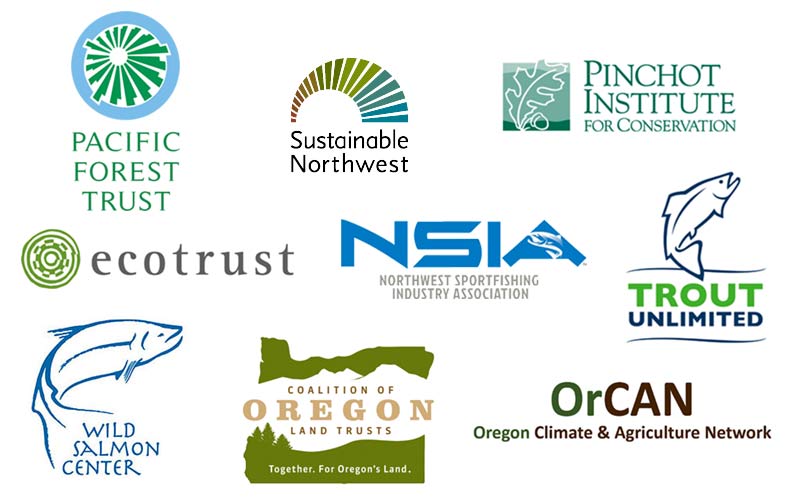
Sign-on Letter: Inclusion of Natural and Working Lands Investments in HB 2020
On March 1st, PFT and several other organizations submitted a letter to the Joint Committee on Carbon Reduction of the Oregon State Legislature in order to express our strong support for the role of natural and working lands; they should be a core of the Climate Investments Fund that would be established by HB 2020, currently being considered in the legislature. Read the full letter below.
Date: March 1, 2019
To: Joint Committee on Carbon Reduction
Co-Chairs Representative Power and Senator Dembrow
Vice Co-Chairs Representative Brock Smith and Senator BentzRe: Inclusion of Natural and Working Lands Investments in HB 2020
Dear Co-Chairs Senator Dembrow and Representative Power, and Members of the Joint Committee on Carbon Reduction:
Thank you for the opportunity to provide comments on HB 2020. We greatly appreciate all of the work you have done to propose a cap and invest program to reduce greenhouse gas emissions. Our organizations are writing to express our strong support for the role of natural and working lands; they should be a core of the Climate Investments Fund. We believe, as affirmed by the IPCC, that forests and land can and must play a very significant role in solving the climate crisis. Natural climate solutions can mitigate 37% of emissions globally, and help us all adapt to a changing world1. To that end, we offer the following proposed amendments:
Page 21, Line 44, Section 29 (2) modify (b), modify (e), add new (g)
(b) Complement efforts to achieve and maintain local air quality, including reducing uncharacteristically intense wildfires and restoring low-intensity fire regimes.
(e) Promote low carbon economic development opportunities and the creation of jobs that sustain living wages, including those in sustainable natural resource management.
(g) Promotes resiliency to climate change and in the economy by prioritizing cost-effective carbon sequestration through investments in natural and working lands.
Page 22, Line 13, Section 30, add (d)
(d) No less than forty percent shall be allocated for projects, programs, or activities as detailed in Section 31, subsections 4, 5, and 9 of this 2019 Act, and managed by the Oregon Watershed Enhancement Board, in consultation with the Carbon Policy Office and other relevant state agencies.
Further, we recommend that you include a new provision in the legislation to require the Carbon Policy office to develop a four to six-year spending plan for the natural and working lands investments to increase efficiency in investing the funds and predictability for landowners and service providers needed to implement the programs.
Page 22, Lines 33-42, modify Section 31 (5), (6), and (9)
Funding to reduce greenhouse gas emissions, support greenhouse gas sequestration or support adaptation or resiliency through investments in natural and working lands, including but not limited to investments in low-carbon emissions agricultural or forestry practices, or the manufacture of sustainable forest products, that serve to reduce greenhouse gas emissions or promote carbon sequestration, forest restoration, restoration of tidal marsh or intertidal areas of estuaries, irrigation efficiency projects, riparian zone restoration projects, methane emissions reduction or recovery projects and biomass pyrolysis projects.
Funding to facilitate the development in Oregon of clean energy infrastructure or technologies, low carbon infrastructure or technologies, carbon capture and storage or carbon- free infrastructure and technologies, including methane recovery projects and biomass pyrolysis projects.
(9) Funding to strengthen adaptation and resilience of fish, wildlife and ecosystems ecosystems and native fish and wildlife to the effects of climate change through investments in projects, including but not limited to projects involving landscape and watershed conservation, instream flow acquisition and protection, fish barrier removal, habitat restoration and enhancement and protection of wildlife corridors, coldwater refugia areas and species strongholds.
Sincerely,
Bob Van Dyk
Oregon and California Policy Director
Wild Salmon CenterBrent Davies
Vice President Forests and Ecosystem Services
EcotrustBrian Kittler
Director, Western Regional Office
Pinchot Institute for ConservationChandra Ferrari
Senior Policy Advisor
Trout UnlimitedDylan Kruse
Director of Government Affairs and Program Strategy
Sustainable NorthwestKaola Swanson
Oregon Program Director
Pacific Forest TrustKelley Beamer
Executive Director
Coalition of Oregon Land TrustsLiz Hamilton
Executive Director
Northwest Sportfishing Industry AssociationMegan Kemple
Volunteer Director
Oregon Climate and Agriculture Network________________
1 “Natural climate solutions can provide 37% of cost-effective CO2 mitigation needed through 2030 for a >66% chance of holding warming to below 2 °C.” (Griscom, Bronson; Adams, Justin; Ellis, Peter; Houghton, Richard; Lomax, Guy; Miteva, Daniela; Schlesinger, William; Shoch, David; Siikamäki, Juha; Smith, Pete; Woodbury, Peter; et al. October 2017. Natural Climate Solutions. PNAS. 114 (44) 11645-11650; https://doi.org/10.1073/pnas.1710465114.)
